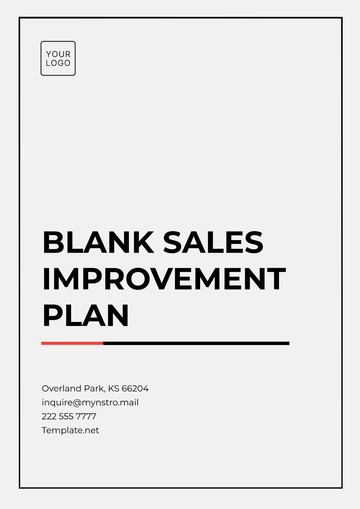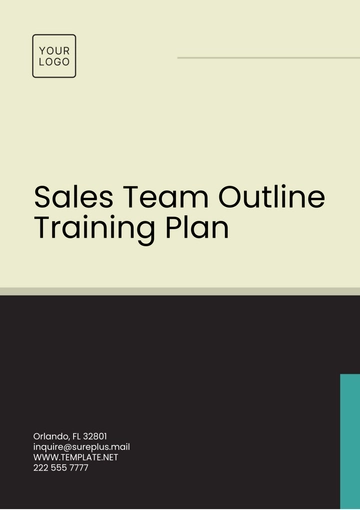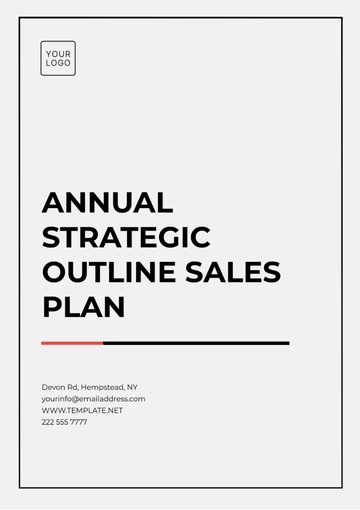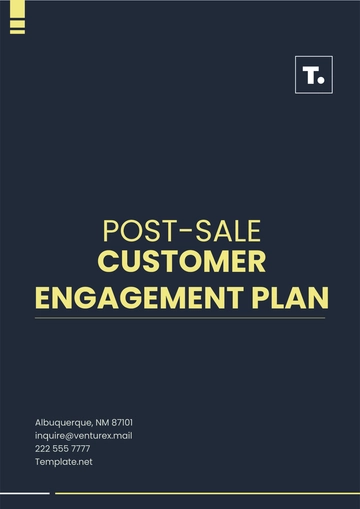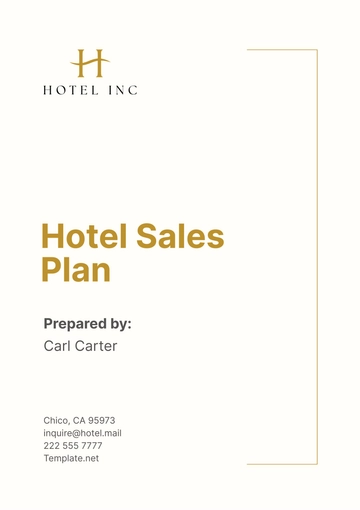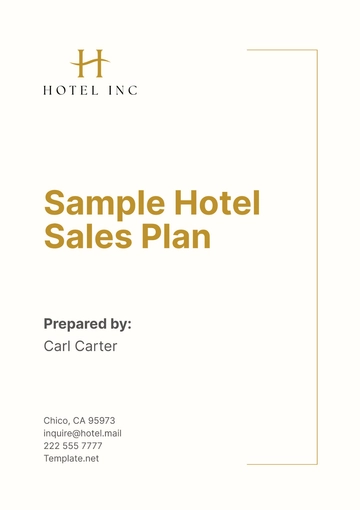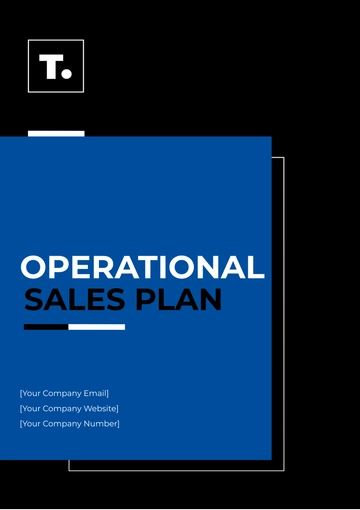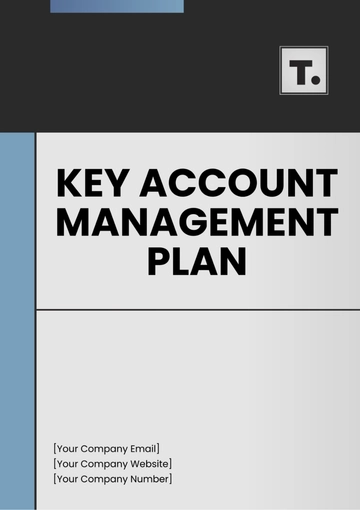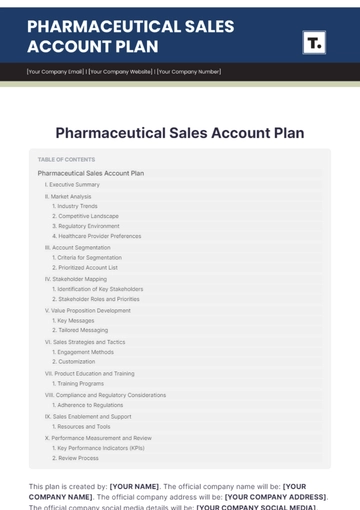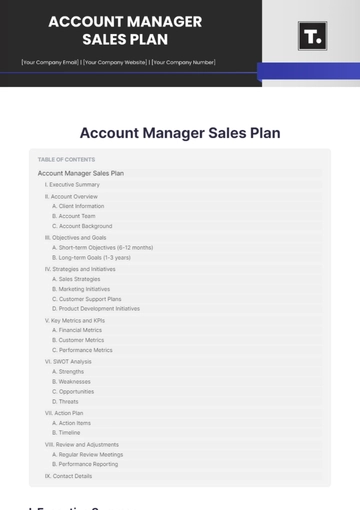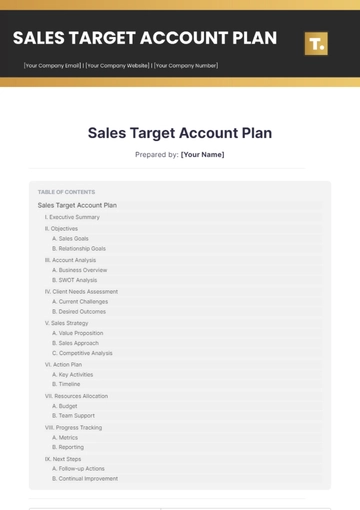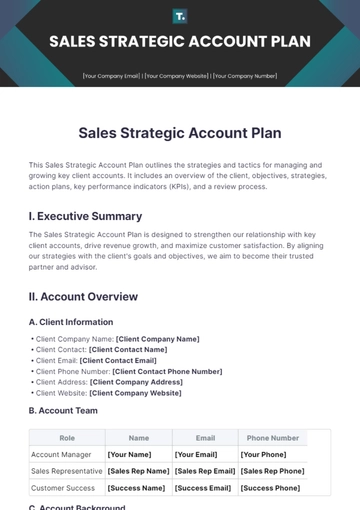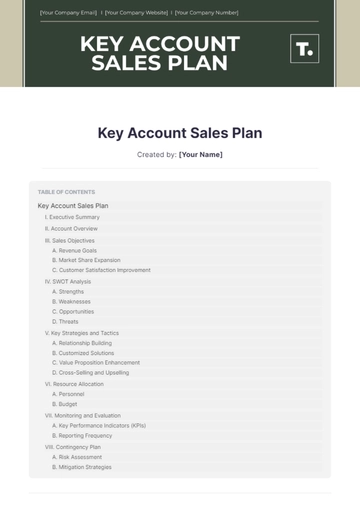Free Sales Recovery Plan
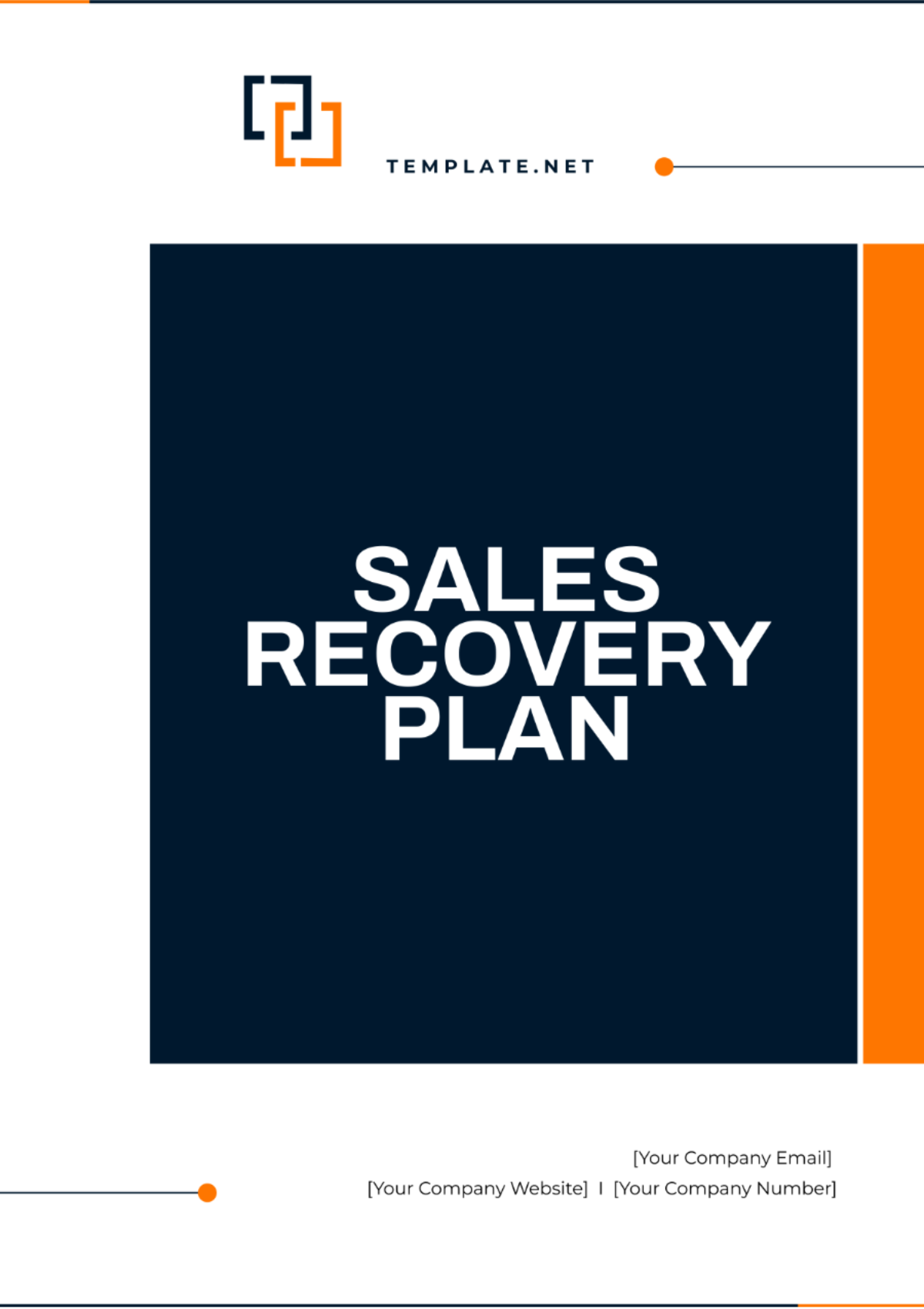
Prepared By: | [Your Name] |
Department: | [Your Department] |
Date: | [Date] |
I. Executive Summary
This Sales Recovery Plan outlines the strategies and actions required to revitalize and improve sales performance at [Your Company Name] after a period of decline or stagnation. It provides actionable insights and a structured approach to achieving our sales goals within a specified timeframe.
II. Specific Goals
A. Short-term Goals
Increase monthly sales by 15% within the next quarter.
Reduce customer churn rate by 10% over the same period.
Launch a new marketing campaign to re-engage dormant customers.
B. Long-term Goals
Achieve a 50% increase in annual sales within the next fiscal year.
Expand market share by entering two new geographic regions.
Build long-term relationships with strategic partners to enhance sales channels.
III. Market Analysis
A. Current Market Status
Analyze the present market conditions, highlighting key factors that have contributed to the decline in sales. This should include a SWOT analysis to identify strengths, weaknesses, opportunities, and threats.
Internal Factors | External Factors |
|---|---|
Strengths: | Opportunities: |
Weaknesses: | Threats: |
B. Target Market
Demographics
Age: 25-40
Gender: Both genders (slightly male-skewed)
Income: Middle to high income ($60,000-$100,000+ annually)
Education: College graduates and above
Psychographics
Lifestyle: Busy professionals seeking time-saving solutions, and interested in tech trends.
Personality Traits: Tech-savvy, value efficiency, and innovation.
Values: Appreciate sustainability and seamless tech integration.
Buying Behavior
Motivations: Quality, time-saving features, value for money.
Channels: Online, mobile apps, tech stores.
Decision Process: Research online, seek recommendations and prioritize features and support.
IV. Strategic Approaches
A. Customer Relationship Management (CRM)
Implementation of CRM Systems: Integrate robust CRM software to track customer interactions across all touchpoints, including sales calls, emails, social media, and website visits.
Data Collection and Analysis: Gather customer data to create detailed profiles, segment customers based on behavior and preferences, and identify opportunities for personalized engagement.
Automated Workflows: Set up automated workflows for lead management, follow-ups, and customer support to ensure timely responses and consistent communication.
Customer Feedback Mechanisms: Implement surveys, feedback forms, and review platforms to gather customer feedback, analyze sentiments, and address concerns proactively.
B. Product Innovation
Market Research: Conduct thorough market research, including competitor analysis and customer feedback, to identify gaps and opportunities in the market.
Cross-functional Collaboration: Work with R&D, marketing, and sales to identify and prioritize new product features or developments based on market needs and customer preferences.
Prototype Testing: Develop prototypes or minimum viable products (MVPs) for testing with target customers to gather feedback and iterate based on real-world usage insights.
Launch Strategy: Plan a comprehensive launch strategy, including marketing campaigns, product demos, and promotions, to generate excitement, educate customers, and drive initial sales.
C. Promotional Strategies
Targeted Campaigns: Segment your audience based on demographics, behavior, or purchase history to create targeted promotional campaigns that resonate with specific customer segments.
Omni-channel Marketing: Utilize a mix of digital and traditional marketing channels such as social media, email marketing, SEO/SEM, content marketing, and offline events to reach a wider audience and reinforce brand messaging.
Incentives and Offers: Offer incentives such as discounts, loyalty rewards, referral programs, or bundled deals to encourage purchases and foster customer loyalty.
Measurable Goals: Set and track measurable goals for promotional campaigns, monitoring KPIs like conversion rates, ROI, CAC, and CLV, and optimizing based on data insights.
V. Actionable Tactics
Host Webinars and Virtual Events
Content: Create engaging, relevant content.
Platform: Choose interactive webinar software.
Promotion: Use email, social media, and website banners.
Follow-up: Send post-event resources and offers.
Offer Limited-Time Discounts and Promotions
Timing: Align with trends or product launches.
Segments: Personalize offers based on data.
Channels: Use email, social media, and partnerships.
Messaging: Communicate terms and dates.
Develop Targeted Email Marketing Campaigns
Segments: Use data to segment emails.
Personalization: Customize content and offers.
Automation: Set up automated workflows.
Analytics: Monitor key performance metrics.
Utilize Social Media
Platforms: Choose based on audience demographics.
Content: Create engaging visuals and copy.
Advertising: Use targeted ads and retargeting.
Engagement: Interact with followers actively.
VI. Sales Team Structure
A. Team Roles and Responsibilities
Outline the roles and responsibilities of each team member, ensuring alignment with the recovery plan objectives.
Role | Responsibilities | Team Member |
|---|---|---|
Sales Manager | - Oversee sales strategies | [Sales Manager Name] |
Account Executive | - Manage client relationships | [Account Executive Name] |
Marketing Specialist | - Plan and execute marketing campaigns | [Marketing Specialist Name] |
VII. Performance Metrics
Establish key performance indicators (KPIs) to track the progress and effectiveness of the sales recovery plan.
Monthly Sales Growth Rate
Definition: Percentage increase in sales revenue from one month to the next.
Calculation: (Current Month Sales - Previous Month Sales) / Previous Month Sales x 100
Example: If April sales were $100,000 and May sales were $120,000, the monthly sales growth rate would be (120,000 - 100,000) / 100,000 x 100 = 20%.
Customer Retention Rate
Definition: Percentage of customers retained over a specific period.
Calculation: (Number of Customers at End of Period - Number of New Customers Acquired) / Number of Customers at Start of Period x 100
Example: If you start with 100 customers, gain 20 new customers, and end with 110 customers, the retention rate would be (110 - 20) / 100 x 100 = 90%.
Lead Conversion Rate
Definition: Percentage of leads that convert into paying customers.
Calculation: (Number of Conversions / Number of Leads) x 100
Example: If you have 500 leads and 50 of them convert into customers, the conversion rate would be (50 / 500) x 100 = 10%.
Average Deal Size
Definition: Average value of each sales deal or transaction.
Calculation: Total Sales Revenue / Number of Deals
Example: If your total sales revenue for a month is $50,000 from 100 deals, the average deal size would be $50,000 / 100 = $500.
VIII. Adaptability Strategies
A. Continuous Monitoring
Sales Performance: Track key performance indicators (KPIs) such as monthly sales growth rate, customer acquisition costs, and sales conversion rates.
Market Conditions: Monitor industry trends, competitor activities, economic changes, and customer behavior shifts.
Data Analysis: Use analytics tools to analyze sales data, customer feedback, and market insights to identify patterns and deviations.
B. Feedback Loop
Customer Feedback: Collect feedback through surveys, reviews, and direct interactions to understand customer satisfaction levels, pain points, and product/service preferences.
Sales Team Input: Regularly gather feedback from sales representatives regarding customer interactions, product feedback, market challenges, and competitive insights.
Stakeholder Collaboration: Engage with marketing teams, product development teams, and leadership to share insights, brainstorm solutions, and align strategies for continuous improvement.
Actionable Insights: Use collected feedback to identify areas for improvement, prioritize initiatives, and implement changes to enhance customer experience, sales processes, and overall business performance.
IX. Resource Allocation
A. Budget Allocation
Allocate a total budget of $100,000 for implementing the sales recovery plan, distributed as follows:
Marketing Campaigns: $40,000
Allocate funds for digital marketing campaigns, social media advertising, email marketing, and promotional materials.
Example initiatives: Google Ads, Facebook Ads, email automation software subscriptions, and content creation costs.
Training Programs: $20,000
Allocate funds for sales team training, workshops, seminars, and skill development programs.
Example initiatives: Sales training workshops, industry certifications, and sales coaching sessions.
Technological Investments: $40,000
Allocate funds for acquiring or upgrading sales CRM software, analytics tools, and sales automation platforms.
Example initiatives: CRM software licenses, sales enablement tools, and data analytics software subscriptions.
B. Personnel Allocation
Assign team members to specific roles and responsibilities within the sales recovery plan:
Sales Manager: [Sales Manager Name]
Oversee sales strategies and monitor team performance.
Responsibilities: Sales planning, goal setting, performance tracking.
Account Executive: [Account Executive Name]
Manage client relationships and drive sales within assigned territories.
Responsibilities: Prospecting, sales presentations, deal negotiations.
Marketing Specialist: [Marketing Specialist Name]
Plan and execute marketing campaigns, analyze market trends, and support sales efforts.
Responsibilities: Campaign development, content creation, lead generation support.
C. Technology Investments
CRM Software: Invest in a robust CRM system such as Salesforce or HubSpot for customer data management, lead tracking, and sales pipeline management.
Analytics Tools: Implement data analytics tools like Google Analytics or Tableau to track sales metrics, campaign performance, and customer insights.
Sales Automation Platforms: Consider investing in sales automation tools like Outreach or SalesLoft for email outreach, follow-ups, and sales process automation.
X. Conclusion
This Sales Recovery Plan provides a comprehensive framework to guide [Your Company Name] in revitalizing its sales performance. By focusing on strategic approaches, actionable tactics, and continuous monitoring, we can navigate through this challenging period and achieve our sales goals. Effective implementation and adherence to this plan will foster sustainable growth and long-term success.
- 100% Customizable, free editor
- Access 1 Million+ Templates, photo’s & graphics
- Download or share as a template
- Click and replace photos, graphics, text, backgrounds
- Resize, crop, AI write & more
- Access advanced editor
Revitalize your sales strategy with Template.net's Sales Recovery Plan Template. This customizable and editable template helps you devise a plan to recover lost sales. Editable in our AI Editor Tool, it offers flexibility to tailor the plan to your business's specific challenges. Implement effective recovery strategies and boost your sales performance with this essential and practical tool.
You may also like
- Finance Plan
- Construction Plan
- Sales Plan
- Development Plan
- Career Plan
- Budget Plan
- HR Plan
- Education Plan
- Transition Plan
- Work Plan
- Training Plan
- Communication Plan
- Operation Plan
- Health And Safety Plan
- Strategy Plan
- Professional Development Plan
- Advertising Plan
- Risk Management Plan
- Restaurant Plan
- School Plan
- Nursing Home Patient Care Plan
- Nursing Care Plan
- Plan Event
- Startup Plan
- Social Media Plan
- Staffing Plan
- Annual Plan
- Content Plan
- Payment Plan
- Implementation Plan
- Hotel Plan
- Workout Plan
- Accounting Plan
- Campaign Plan
- Essay Plan
- 30 60 90 Day Plan
- Research Plan
- Recruitment Plan
- 90 Day Plan
- Quarterly Plan
- Emergency Plan
- 5 Year Plan
- Gym Plan
- Personal Plan
- IT and Software Plan
- Treatment Plan
- Real Estate Plan
- Law Firm Plan
- Healthcare Plan
- Improvement Plan
- Media Plan
- 5 Year Business Plan
- Learning Plan
- Marketing Campaign Plan
- Travel Agency Plan
- Cleaning Services Plan
- Interior Design Plan
- Performance Plan
- PR Plan
- Birth Plan
- Life Plan
- SEO Plan
- Disaster Recovery Plan
- Continuity Plan
- Launch Plan
- Legal Plan
- Behavior Plan
- Performance Improvement Plan
- Salon Plan
- Security Plan
- Security Management Plan
- Employee Development Plan
- Quality Plan
- Service Improvement Plan
- Growth Plan
- Incident Response Plan
- Basketball Plan
- Emergency Action Plan
- Product Launch Plan
- Spa Plan
- Employee Training Plan
- Data Analysis Plan
- Employee Action Plan
- Territory Plan
- Audit Plan
- Classroom Plan
- Activity Plan
- Parenting Plan
- Care Plan
- Project Execution Plan
- Exercise Plan
- Internship Plan
- Software Development Plan
- Continuous Improvement Plan
- Leave Plan
- 90 Day Sales Plan
- Advertising Agency Plan
- Employee Transition Plan
- Smart Action Plan
- Workplace Safety Plan
- Behavior Change Plan
- Contingency Plan
- Continuity of Operations Plan
- Health Plan
- Quality Control Plan
- Self Plan
- Sports Development Plan
- Change Management Plan
- Ecommerce Plan
- Personal Financial Plan
- Process Improvement Plan
- 30-60-90 Day Sales Plan
- Crisis Management Plan
- Engagement Plan
- Execution Plan
- Pandemic Plan
- Quality Assurance Plan
- Service Continuity Plan
- Agile Project Plan
- Fundraising Plan
- Job Transition Plan
- Asset Maintenance Plan
- Maintenance Plan
- Software Test Plan
- Staff Training and Development Plan
- 3 Year Plan
- Brand Activation Plan
- Release Plan
- Resource Plan
- Risk Mitigation Plan
- Teacher Plan
- 30 60 90 Day Plan for New Manager
- Food Safety Plan
- Food Truck Plan
- Hiring Plan
- Quality Management Plan
- Wellness Plan
- Behavior Intervention Plan
- Bonus Plan
- Investment Plan
- Maternity Leave Plan
- Pandemic Response Plan
- Succession Planning
- Coaching Plan
- Configuration Management Plan
- Remote Work Plan
- Self Care Plan
- Teaching Plan
- 100-Day Plan
- HACCP Plan
- Student Plan
- Sustainability Plan
- 30 60 90 Day Plan for Interview
- Access Plan
- Site Specific Safety Plan

